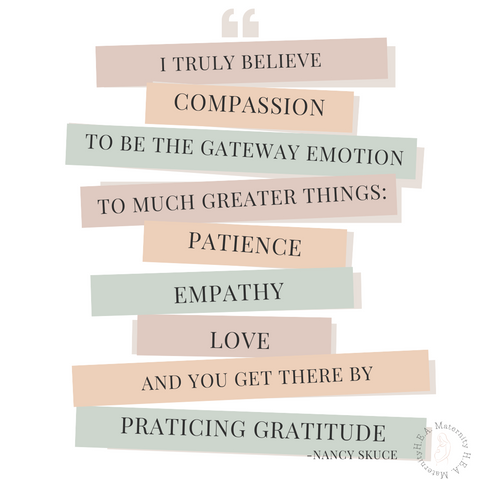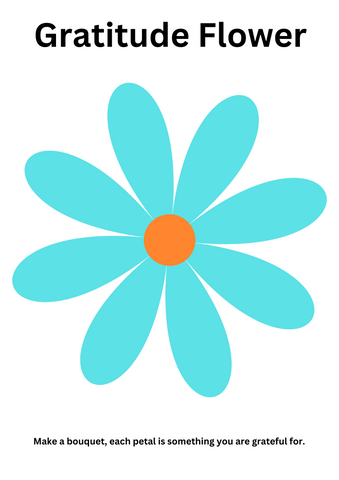How to be a better parent: A Gratitude Practice
I think it’s fair to say that we’ve all heard the terms gratitude and mindfulness. The idea behind these practices is to be conscious as you go through life, to be in the moment, and to shift your focus to celebrate the good. We’re all pre-programed with a negativity bias. Focusing on the positives in our life takes some effort and that’s the truth for us all. We have human biology to thank for that. Gratitude will make you a more compassionate person. Compassion is the gateway emotion to much greater things: patience, empathy, and love. It also has benefits for your health and relationships.

What is a Gratitude Practice?
A gratitude practice retrains your brain to notice the good moments, big and small, in your life. It puts you in touch with yourself and how you feel. And it starts to shift you away from your negativity bias. Your practice can be private or public or both.
Building your capacity for gratitude isn’t hard. It takes consistency over time. The more you bring your attention to moments of gratitude, the more you’ll notice moments of gratitude in your life. Overtime your mind won’t be stuck dwelling on what didn’t go right or what made you upset. You’ll be able to find gratitude for allowing you to move on and stop ruminating.
Gratitude basically breaks down into two parts: 1) Acknowledgement. Feelings. You acknowledge the good and bad but change your focus to the good, and you are thankful for the good.2) Awareness. Things and people exist outside of yourself, and they matter too. It’s not always about you, we get so caught up in our own drama that we forget we are just a small speck in the universe.

Benefits of Practicing Gratitude
Why is it gratitude so powerful? Gratitude allows us to celebrate the present; it diverts our attention from toxic, negative emotions, such as envy, resentment, and debilitating regret, all of which can lead to anger and depression.
Research has linked gratitude with a wide range of benefits, including strengthening your immune system, improving sleep patterns, feeling optimistic, experiencing more joy, increase in self-esteem, being more helpful and generous, and limits feelings of loneliness, and isolated. Grateful people enjoy higher wellbeing and happiness and reduced symptoms of depression. Gratitude gives you the tools to overcome the emotional ups and downs of a regular day. You’ll see better results in your practice overtime.

Should you practice gratitude every day?
Yes & No
In public yes you should try to remember to look at the positive in at least one situation a day. Start with your commute. There’s usually something to set off our impatience when we’re travelling.
In a private practice like journaling, no you shouldn’t. Not at first anyway. Gratitude will become a habit over time. Starting with three times a week is a good place to begin. Forcing yourself to practice everyday when you first start out is going to take the sincerity out of the practice. It’ll be hard, and will start to feel like a chore. You might draw blanks, get upset with yourself, and you’ll stop your practice before you can even get it started. Aim for 3 times per week when you first get started.

How to practice Gratitude
Public Practices
Start with Observation
Do you express your gratitude to others? For example. When you’re checking out at the grocery store, do you thank the cashier? Now, when you thank them, are you making eye contact, of absentmindedly thanking them as you put your card in back in your wallet?
Be in the Moment
Gratitude is conscious intention. When you thank the people in your life, make sure you’re in the moment with them, not speaking at them. Eye contact is key. Notice the difference in how you feel afterwards, and how their body language or facial expression changes. Gratitude is a meaningful connection.
Remind people why you love them
You shouldn’t limit this to the strangers in your life. Research has found that expressing gratitude can strengthen relationships. Share your gratitude with your friends, family, coworkers, and partner.

It’s not always about you: Why we’ve become so self centred
Social media has made us all a bit narcissistic. Narcissism is typically divided into two categories: 1) Grandiose narcissism, characterized by feelings of superiority and entitlement, and 2) Vulnerable narcissism, characterized by hypersensitivity to criticism and a constant need for reassurance. Since social media focuses on sharing one’s own image and opinions, it’s singled us out and created a “what about me” culture. Social media is making us forget that the world we live in is not just about us. In the real world, we seldom find ourselves in situations alone. But we always make situations about us, how we feel (usually negative), and how we are inconvenienced.
It can be hard to take ourselves out of the situations we find ourselves in and realize that it’s not just about us in that moment. For example. You’re running late, you’re stuck in traffic and the car in front of you lets another car in in front of them. Now you’re one car further back and further from your destination. It’s about you and how you’re late and this “idiot” just let someone else in.
“When you live a life centered in self, you are closed, your thoughts are turned inward, and you are listening to a constant inner dialogue of judgment and criticism.” The Angry Therapist
Accept your feelings but not the judgmental thoughts behind them. Allow yourself to feel whatever feeling that is truthful then let it go because it’s temporary.
From our Example, How are you feeling? Recognize your feelings. Powerlessness. Annoyance with yourself and with the other driver. Anxiousness that’s possibly turning into anger as a defence mechanism. Impatience. General stress. Keep it to emotional recognitions. No judgement. If you could have left earlier, you would have.
Now make it about the other driver. Think about how the driver who was let in. How grateful that driver must be feeling right now. Mentally thank the driver in front of you for creating that moment of gratitude in another person’s life. It will ease your emotions instantly. It will bring you back to the moment, and make you realize that there’s nothing you can change about this moment. It’s time to just be.

Private practices
This is often the easiest way for some people to start. Expressing gratitude to other people can be uncomfortable and weird at first. But in private you can practice without fear of judgement.
Document your gratitude. In a journal, using the image of a tree or flower, or in a jar on small scraps of paper. Writing down a few things you’re grateful for is one of the easiest and most popular exercises.

Journal
Mentally go through your day and find moments of gratitude in other people, events, or yourself, and write them down. Reflection is a good way to identify moments of gratitude even when we didn’t feel gratitude in the moment. It’s a practice, that means it takes time to build the gratitude muscle. You can find one thing you’re grateful for or 3. It can be practiced daily or weekly.
Do it by hand, not digitally. Having a gratitude journal that is visible on your bed stand (or somewhere else in your living space) is a good visual reminder for your practice. And handwriting is better for your brain than typing. Recent studies show that areas of the brain associated with working memory, recall, and comprehension are more engaged when people write by hand than when they type. Writing longhand away from your smartphone, tablet, or computer can help you focus on writing and limit distractions. Handwriting is also beneficial for visual learners since it gives them more freedom in the format used to record the information.

Jar
For the jar technique, you write down what you’re grateful for on strips of paper and put them in the jar or box for later reading.

Flower
Gratitude Tree or flower – a piece of visual art to remind you of what/who you are grateful for and a visual reminder to practice your gratitude. You build this as you practice. You can also incorporate adult colouring into this to make it a longer practice. We have sheets made up for this.

Rock
A private reminder rock or object of choice some people choose a piece of jewelry they wear everyday or only on days they know will be challenging.
The secret to this exercise is that the rock is a symbol, a physical object you can use, to remind yourself of what you have. Leave it on your bedside, or carry it in your pocket. Whenever you see it or touch it, pause to think about at least one thing you are grateful for. Something big or small. Something as simple as being grateful you woke up today.

What’s going to get in the way of your Practice
1st The primary obstacle to gratitude is forgetfulness. Visual reminders will help remind you to add your mindfulness practice to your day. Examples: Affirmation – framed on your beside or in the bathroom or kitchen. Rock – write your own gratitude vow- leave it where you’ll see it. On the cabinet door that holds your coffee, medicine cabinet where you brush your teeth.
2nd The biggest obstacles to motivation and determination is being human. If you start to get bored, don’t get stuck and don’t stop. Challenge yourself with a new way to document your gratitude or pick themes to look for in your day.
Once gratitude starts to work, there’s a very human instinct that kicks in to make you stop. You’ve accomplished what you set out to do. You have all the good feels. But the only way the good feels will stay is if you keep up with your practice. Don’t allow yourself to stop when it feels good.
3rd the abundance of choice revealed buy a google search. Google’s going to spit our ridiculous titles like “13 best practice’s”, “40 gratitude practices,” “35 ways to practice” …..it’s really not that complicated. The more complicated you make it the less likely you’ll be to success. So stop with the google, and stick to the basics in this guide, make your plan and start.
Like everything we do in life, it’s important to remember the why. Why are you starting this gratitude practice? Put that on a page in your journal, or somewhere you will see it often. Going back to the why can be the strength that will keep your practice going.

Gratitude will make you a more compassionate person, to yourself and others. It will change your self view and transform you into a calmer, gentler, more compassionate person. I truly believe compassion to be the gateway emotion to much greater things:
patience, with ourselves and others
empathy, the ability to listen to the story of what it’s like to be in someone else’s shoes, and to believe themeven when your experience doesn’t match theirs.
and love.
Forget New Years resolutions for 2023, work on gratitude. With gratitude you’ll take better care of your emotional and physical health, you’ll separate your emotions from judgement which will uncomplicate your life, and you’ll connect better with the people around you. What more could you ask for of yourself?

P.S. Here's some blank images you can screen shot or save to fill in yourself.





